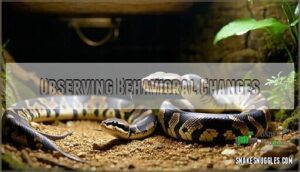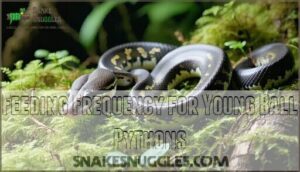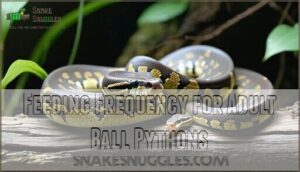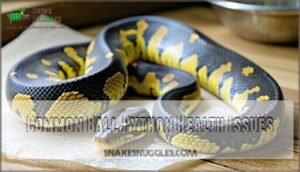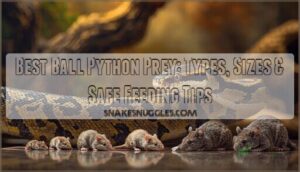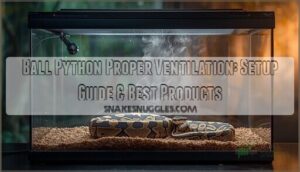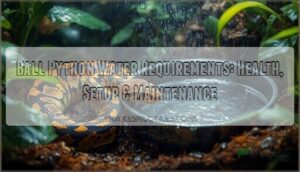This site is supported by our readers. We may earn a commission, at no cost to you, if you purchase through links.
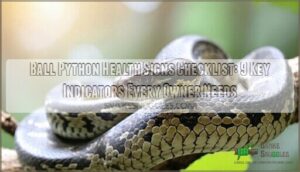
Watch for clear, bright eyes (unless it’s shedding time), a clean pink mouth, and steady breathing without wheezing sounds.
You’ll want to track eating habits, monitor body weight, and observe normal behavior patterns like regular movement and proper muscle tone.
Temperature and humidity levels matter too, since off conditions often trigger health problems before you notice physical symptoms.
Smart owners also check for mites, unusual discharge, or changes in shedding patterns.
The real secret lies in knowing which subtle warning signs most people miss completely, and understanding the importance of a clean pink mouth.
Table Of Contents
- Key Takeaways
- Healthy Ball Python Signs
- Ball Python Health Checklist
- Top 9 Ball Python Health Products
- 1. Zilla Shed Ease Reptile Bath
- 2. Gargeer Reptile Probiotics Gut Health
- 3. WiFi Reptile Mister Terrarium Misting System
- 4. Ball Python Health and Care Journal
- 5. Funny Ball Python Retro Sign
- 6. Breeding Ball Pythons A Practical Guide
- 7. Reptile Thermometer Humidity Gauge 2 Pack
- 8. Ball Python Care and Health Log
- 9. Reptile Oral Health Support Tablets
- Ball Python Feeding Schedule
- Ball Python Enclosure Requirements
- Common Ball Python Health Issues
- Preventing Ball Python Health Problems
- Frequently Asked Questions (FAQs)
- How do you know if a ball python is healthy?
- Do ball pythons get sick?
- How do you know if a ball python is stressed?
- How do you know if a ball python is sick?
- How do you keep a ball python healthy?
- Do ball pythons have respiratory problems?
- How to tell if a ball python is healthy?
- What is the average life expectancy of a ball python?
- How to tell if your ball python is a healthy weight?
- How often should ball pythons shed their skin?
- Conclusion
Key Takeaways
- You’ll check your ball python’s scales for smooth, glossy appearance and bright, clear eyes to spot health issues early before they become serious problems.
- You’ll maintain proper temperature gradients (78-92°F) and humidity levels (50-60%) since environmental conditions directly impact your snake’s respiratory health and shedding success.
- You’ll monitor feeding habits, weight changes, and behavioral patterns weekly to catch appetite loss, stress signs, or illness before they escalate into emergencies.
- You’ll establish regular veterinary checkups and daily observation routines to prevent common issues like respiratory infections, mouth rot, and parasite infestations through early detection.
Healthy Ball Python Signs
Recognizing healthy ball python signs helps you catch problems early and keep your snake thriving.
You’ll want to check specific physical traits, behaviors, and environmental factors that indicate your ball python is in peak condition.
Physical Health Indicators
Your ball python’s physical appearance tells you everything about their health.
Your snake’s appearance is the window to their wellbeing – healthy scales and bright eyes reveal everything you need to know.
Check their scale condition regularly – healthy scales should be smooth, shiny, and evenly colored without any redness or swelling.
Eye clarity is vital; clear, bright eyes indicate good health, while cloudiness suggests issues.
Monitor their body shape for proper muscle tone – they shouldn’t look too thin or overweight.
Always inspect the vent area for cleanliness and normal appearance.
Regular checks help guarantee optimal ball python health.
Behavioral Health Signs
Beyond physical appearance, your ball python’s behavior tells the real story of their wellbeing. Watch for these key behavioral indicators:
- Exploration Activity – Your snake should actively explore their enclosure, especially at night when they’re naturally most active.
- Tongue Flicking – Frequent tongue flicking shows curiosity and engagement with their environment, indicating good neurological health.
- Hiding Behavior – Healthy snakes alternate between hiding and exploring. Constant hiding or never hiding both signal potential stress.
- Eating Habits – Consistent appetite and feeding response demonstrate overall health, though occasional fasting is normal.
- Stress Signs – Look for defensive postures, excessive pacing, or glass-surfing, which indicate environmental issues need addressing.
Any sudden snake behavior changes warrant closer monitoring for reptile lethargy causes or other health concerns.
Enclosure and Environmental Needs
Your ball python’s environment directly impacts its health.
A clean enclosure sized at least as long as your snake helps prevent stress and disease.
Maintain a temperature gradient from 78-82°F on the cool side to 88-92°F on the warm side.
Keep humidity levels between 50-60% with proper substrate types like aspen shavings or cypress mulch.
Provide adequate hiding spots on both temperature zones to create a safe environment where your python feels secure.
Ball Python Health Checklist
You’ll need a systematic approach to monitor your ball python’s health effectively. Creating a routine checklist helps you spot potential problems before they become serious health concerns.
Monitoring Temperature and Humidity
You can’t wing it with temperature and humidity – your ball python’s health depends on precise monitoring.
Temperature gradients between 78-92°F and humidity levels at 50-60% require consistent tracking through proper equipment placement and regular calibration.
Many owners purchase reptile humidity products to maintain proper levels.
- Hygrometer placement: Position digital gauges at both warm and cool ends for accurate readings
- Thermostat calibration: Check accuracy monthly using backup thermometers to prevent dangerous fluctuations
- Temperature control: Maintain gradients with separate heating elements and monitoring systems
- Seasonal adjustments: Modify heating and humidity sources based on room temperature changes throughout the year
Tracking Feeding Habits
Every week, document your snake’s feeding schedule to catch appetite changes early.
Record prey size, feeding dates, and any prey refusal incidents in feeding logs.
Watch for regurgitation causes like improper temperatures or oversized meals.
Monitor your python’s weight monthly, as gradual weight loss often signals health issues before other symptoms appear.
Consistent appetite tracking prevents serious problems, and helps in identifying issues like regurgitation causes, and maintaining a healthy weight through consistent appetite tracking.
Observing Behavioral Changes
Watching your ball python’s daily habits helps you spot health issues before they become serious problems.
Notice when Activity Levels drop suddenly or when your snake stops its usual Tongue Flicking during evening explorations.
Healthy behavior includes regular Hiding Behavior patterns and steady Eating Habits, while Stress Signs like constant pacing or defensive postures signal trouble brewing.
Top 9 Ball Python Health Products
You’ll need the right tools to monitor your ball python’s health effectively and catch potential issues before they become serious problems.
These nine carefully selected products help you track essential signs, maintain proper environmental conditions, and support your snake’s overall well-being with professional-grade accuracy, which is crucial for maintaining the health of your ball python with professional-grade tools.
1. Zilla Shed Ease Reptile Bath
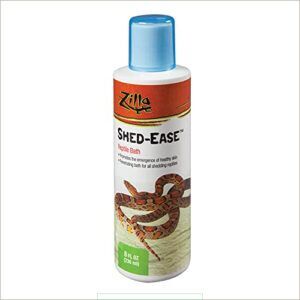
Struggling with stubborn shed around your ball python’s eyes or tail tip?
Zilla Shed Ease Reptile Bath transforms tricky shedding situations into smooth sailing.
The aloe vera formula works gently but effectively, helping even the most challenging sheds come off in satisfying sheets rather than annoying patches.
Simply mix 10ml with 16oz of lukewarm water, let your snake soak for 20 minutes, and watch that old skin soften like butter.
Best For: Reptile owners dealing with stuck or difficult sheds, especially for lizards and snakes like ball pythons, geckos, and bearded dragons.
- Effectively loosens stubborn shed, making removal easier and reducing risk of injury
- Contains aloe vera for gentle, soothing care during shedding
- Simple to use with clear instructions for soaking or spraying
- Not a fix for underlying husbandry issues like improper humidity
- Does not treat infections or severe skin problems—vet care needed for those
- Results can vary depending on species and environment
2. Gargeer Reptile Probiotics Gut Health
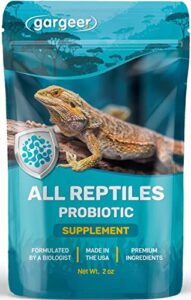
Inside your ball python’s digestive system lies a complex ecosystem that directly impacts their health, appetite, and immune function.
Gargeer Reptile Probiotics delivers three strains of live beneficial bacteria designed to restore gut balance after illness, stress, or antibiotic treatments.
You’ll mix one teaspoon per pound of food, creating an ultrafine coating that adheres perfectly to feeder insects.
This premium blend enhances nutrient absorption while inhibiting harmful bacteria growth, supporting your snake’s natural defenses against digestive issues, which is crucial for maintaining their overall health.
Best For: Ball python and other reptile owners looking to boost gut health, appetite, and digestion—especially after stress, illness, or antibiotic use.
- Supports digestive balance and immune health with live beneficial bacteria
- Easy to use—ultrafine powder sticks well to food and feeder insects
- Can help improve appetite, nutrient absorption, and recovery from digestive upsets
- Only three probiotic strains included, which may limit diverse benefits
- Contains Aspergillus oryzae, a fungus with unclear long-term safety for reptiles
- Dosage instructions may be hard to follow for very small reptiles with low food intake
3. WiFi Reptile Mister Terrarium Misting System
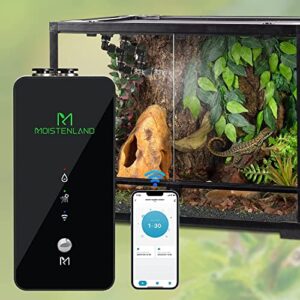
For maintaining ideal humidity in your ball python’s habitat, a WiFi reptile mister delivers consistent environmental control that prevents dangerous fluctuations.
You’ll control misting schedules remotely through smartphone apps, ensuring your snake maintains the essential 50-60% humidity levels needed for healthy shedding and respiratory function.
The automated system prevents the guesswork of manual spraying while providing adjustable nozzles for precise coverage. Most systems support multiple enclosures and offer programmable intervals that adapt to seasonal changes.
However, be aware that these systems require regular maintenance to prevent potential bacterial growth, which is crucial for the health of your ball python.
Best For: Ball python and reptile keepers who want remote, automated humidity control with reliable, customizable schedules.
- Needs regular upkeep to prevent bacterial growth and keep nozzles working well.
- Pump and spray noise can bother some users, especially in quiet spaces.
- Occasional tech glitches or low-quality parts reported, especially with budget systems.
- Delivers precise, consistent humidity that helps prevent shedding and breathing problems.
- Lets you adjust and monitor misting through an easy-to-use smartphone app, even when you’re away.
- Quick setup and flexible design fit most enclosures and support more than one tank if needed.
4. Ball Python Health and Care Journal

Keeping accurate records transforms guesswork into informed care decisions for your ball python.
A dedicated health and care journal tracks essential metrics like feeding schedules, weight changes, shedding cycles, and environmental conditions with precision.
These specialized notebooks feature customizable sections for veterinary visits, breeding records, and behavioral observations.
You’ll spot concerning patterns early, like irregular feeding or problematic sheds, enabling proactive intervention.
Quality journals include growth charts, temperature logs, and space for multiple snakes if you’re managing a collection, which helps in making informed decisions about your ball python’s health and care and allows for proactive intervention and better environmental conditions.
Best For: Terrarium enthusiasts, breeders, and ball python owners who want organized, detailed tracking of their snake’s health, breeding, and care routines.
- Comprehensive logs for feeding, weight, shedding, and vet visits promote proactive health monitoring.
- Customizable sections and growth charts make it easy to tailor records to individual snakes or breeding programs.
- Encourages early detection of health issues through routine documentation and visual trends.
- Requires consistent record-keeping, which may be time-consuming for some owners.
- More detailed than casual keepers might need for a single snake.
- Physical journals could be misplaced or damaged without digital backup.
5. Funny Ball Python Retro Sign
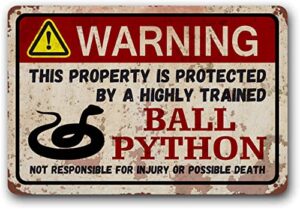
Pride in your pet ownership shines through thoughtful décor choices that celebrate your ball python companion.
This retro aluminum sign adds personality to your reptile room while sparking conversations with fellow enthusiasts.
The UV-resistant coating guarantees vibrant colors won’t fade, while pre-drilled holes make installation effortless, and at 12×8 inches, it’s perfectly sized for habitat areas without overwhelming the space.
Customer reviews consistently praise its durability and humor factor, making it an ideal gift for snake lovers seeking unique wall art that celebrates their pet ownership with thoughtful décor.
Best For: Snake enthusiasts and pet owners looking to add a quirky, durable accent to their reptile spaces or themed rooms.
- Primarily decorative and doesn’t offer practical habitat benefits for the reptile.
- Vintage aesthetic may not match all interior themes.
- Size options may not suit customers needing much larger signage.
- Durable, waterproof, and UV-resistant construction ensures long-lasting use.
- Easy to install with pre-drilled holes and lightweight design.
- Retro, humorous design sparks conversation and suits a variety of décor styles.
6. Breeding Ball Pythons A Practical Guide

Breeding knowledge proves invaluable when monitoring your ball python’s reproductive health cycles.
This thorough guide covers breeding eligibility, pairing protocols, and incubation techniques that directly impact your snake’s well-being.
You’ll learn to recognize pre-breeding behaviors, follicle development, and post-breeding care requirements.
While primarily focused on reproduction, understanding these processes helps you identify normal versus concerning changes in appetite, weight, and behavior throughout your python’s life, which is crucial for its overall well-being.
Best For: Beginners or new ball python keepers seeking a basic, step-by-step outline for breeding and care.
- Covers all major stages of ball python breeding from selection to hatchlings.
- Simple instructions make it approachable for first-time breeders.
- Helpful for recognizing normal and abnormal reproductive behaviors.
- Lacks depth and detail found in free online resources and videos.
- Large font and repetitive content can make it feel padded and less professional.
- Not comprehensive enough for experienced breeders seeking advanced techniques.
7. Reptile Thermometer Humidity Gauge 2 Pack
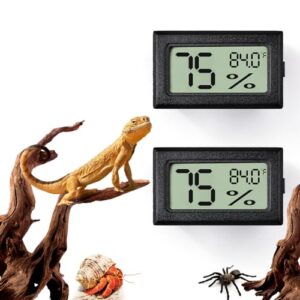
Your snake’s comfort depends on accurate environmental monitoring, and this 2-pack thermometer-hygrometer combo delivers reliable temperature and humidity readings.
These digital gauges feature fast 5-second response times and clear displays showing temperatures from -58°F to 158°F with humidity ranges of 10-99%.
Easy adhesive installation keeps units secure on tank walls, and while battery life averages 3 months, the affordable price makes replacement simple when needed for consistent environmental control.
Best For: Reptile owners who want an affordable, easy-to-read way to monitor both temperature and humidity in their pets’ enclosures.
- Battery life is short, usually about 3 months
- Occasional issues with humidity accuracy and missing batteries
- No manual or detailed instructions included
- Quick, clear digital readings for both temperature and humidity
- Easy adhesive setup with compact, space-saving design
- Affordable price for a set of two units
8. Ball Python Care and Health Log
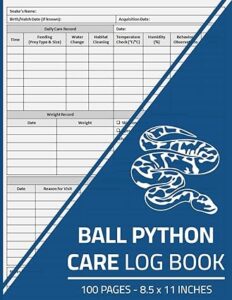
Documentation becomes your safety net when tracking your ball python’s wellness journey.
This 100-page physical journal provides dedicated sections for daily observations, feeding schedules, and environmental monitoring.
You’ll record weight changes, shedding events, and behavioral patterns that help identify health issues before they become serious problems.
The structured format includes symptom checklists and space for veterinary notes, making it easier to spot trends and communicate effectively with reptile vets during check-ups, ensuring a better understanding of your pet’s overall wellness journey and facilitating effective communication.
Best For: New and experienced ball python owners who want to monitor their pet’s health, feeding, and environment with a structured, easy-to-use paper journal.
- Provides dedicated sections for tracking daily health, feeding, and environmental details, helping catch issues early.
- Includes symptom checklists and space for veterinary notes, making vet visits more informative.
- Encourages consistent, responsible care and simplifies long-term health monitoring.
- Physical format means it doesn’t automatically sync data or provide reminders.
- Can be less convenient to update compared to digital logs, especially for multiple pets.
- Journal can be lost or damaged if not stored properly.
9. Reptile Oral Health Support Tablets
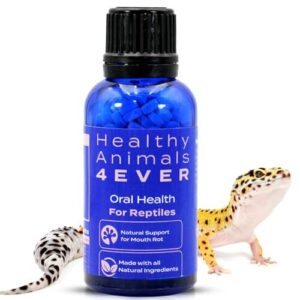
Prevention is your best defense against oral health issues in ball pythons.
These natural homeopathic tablets support healthy mouth tissue and help prevent bacterial infections like mouth rot. You’ll dissolve them in water or mix into food based on your snake’s weight.
Made from ingredients like Borax and Chamomilla, they’re safe for daily use without harsh chemicals.
While not a miracle cure, consistent use alongside proper husbandry creates a foundation for long-term oral health maintenance, which is essential for the overall well-being of your ball python, relying on daily use.
Best For: Reptile owners who want a gentle, daily oral health supplement to help prevent mouth rot and support overall mouth comfort in ball pythons and other reptiles.
- Results are gradual, requiring consistent, long-term use
- Lacks large-scale scientific studies on efficacy
- Not a substitute for professional veterinary care in severe cases
- All-natural, homeopathic ingredients without synthetic chemicals
- Easy to use daily; dissolves in water or mixes into food
- Supports prevention and recovery from common oral issues like mouth rot
Ball Python Feeding Schedule
You’ll need to establish a consistent feeding schedule that matches your ball python’s age and size to maintain ideal health.
Proper feeding frequency prevents obesity while ensuring adequate nutrition, with young snakes requiring more frequent meals than adults.
Determining Prey Size
When determining proper prey size for your ball python, the girth ratio serves as your golden rule. Choose prey that’s 1-1.5 times your snake’s thickest body section to prevent overfeeding signs and digestive issues.
Consider these prey type guidelines:
- Match the prey’s widest point to your python’s thickest area
- Juvenile portions should lean toward the smaller end of this range
- Monitor your snake’s appetite and hunger cues after each meal
Avoid feeding multiple smaller items, as this can strain digestion and disrupt natural feeding habits. Proper prey size selection guarantees healthy growth without overwhelming your python’s system.
Feeding Frequency for Young Ball Pythons
Young ball pythons grow fast and need consistent fuel. During their first year, you’ll feed them every 5-7 days to support their rapid Growth Rate. This Feeding Schedule prevents Regurgitation Risks while meeting their Supplementation Needs. Ball python feeding at this stage requires careful attention to timing.
| Age Range | Feeding Frequency |
|---|---|
| 0-3 months | Every 5 days |
| 3-6 months | Every 5-6 days |
| 6-9 months | Every 6 days |
| 9-12 months | Every 6-7 days |
| 12+ months | Every 7 days |
Snake nutrition depends on consistency during growth phases.
Feeding Frequency for Adult Ball Pythons
Adult ball pythons thrive on a more relaxed feeding schedule compared to their younger counterparts.
You’ll want to feed your mature snake every 7-14 days, allowing their slower metabolism to work efficiently.
- Overfeeding risks include obesity and regurgitation – your snake’s waistline matters
- Fasting periods of 2-4 weeks are completely normal, don’t panic
- Prey size should match 1-1.5 times your python’s thickest section
- Weight monitoring helps you adjust meal portions and feeding habits perfectly
Ball Python Enclosure Requirements
Your ball python’s enclosure acts as its entire world, so getting the environment right directly impacts your snake’s health and happiness.
Proper temperature gradients, humidity control, and hiding spots create the foundation for a thriving ball python that exhibits natural behaviors and maintains peak health.
Maintaining Temperature Gradients
Proper temperature management creates distinct zones that keep your ball python healthy and active. You’ll need heating methods like ceramic heaters or under-tank heaters with reliable thermostat calibration to maintain consistent warmth.
Monitoring tools help you track these snake temperature zones daily.
| Temperature Zone | Day Range | Night Range |
|---|---|---|
| Warm End | 88-92°F | 80-85°F |
| Cool End | 78-82°F | 75-80°F |
| Basking Spot | 95°F | 88°F |
Gradient importance can’t be overstated—your snake needs options to regulate its body temperature naturally. Seasonal adjustments may require tweaking settings as room temperatures change throughout the year, which is crucial for maintaining the right temperature zones for your ball python.
Controlling Humidity Levels
Humidity control acts like a thermostat for your ball python’s comfort zone.
You’ll need humidity levels between 50-60%, with humidity monitoring using digital gauges placed at both ends.
Proper humidity management guarantees shedding success and prevents mold prevention issues.
Create hydration methods through water bowls and humid hides.
Snake humidity requires gradient importance throughout the enclosure for peak health.
Maintaining proper humidity is essential for preventing respiratory infections.
Providing Adequate Hiding Spots
Your ball python needs multiple hides for stress reduction and essential snake health signs. Hide placement matters—position secure hides on both warm and cool sides. Hide size should allow your snake to curl up completely while touching the walls.
Providing them with secure hiding locations is vital for their well-being.
- Multiple hides: Provide at least three hiding spots throughout different temperature zones
- Proper hide size: Choose hides where your snake can coil while sides touch their body
- Strategic hide placement: Position one hide on warm side, one on cool side, one mid-gradient
These snake hiding spots create a secure habitat where your python feels safe to rest and digest properly.
Common Ball Python Health Issues
Even healthy ball pythons can develop serious health problems that require immediate attention from experienced reptile owners.
Recognizing the early warning signs of respiratory infections, shedding difficulties, parasite infestations, and mouth rot can mean the difference between a quick recovery and a life-threatening condition.
Respiratory Infections
When your python starts wheezing or making clicking sounds, you’re likely dealing with a respiratory infection.
Symptoms include open-mouthed breathing, nasal discharge, and lethargy.
Causes typically stem from poor husbandry—low temperatures or humidity create perfect conditions for bacteria.
Treatment requires immediate environmental correction plus veterinary antibiotics.
Prevention means maintaining proper temperature gradients and humidity levels consistently.
These infections can also stem from opportunistic bacterial agents that thrive when the snake’s immune system is suppressed.
Shedding Problems
Your snake’s shedding process can hit snags when humidity levels drop below ideal ranges.
Stuck shed around the eyes, tail, and toes creates serious health risks if left untreated.
- Eye Caps – Retained eye caps appear as cloudy films over the eyes
- Humidity Levels – Maintain 50-60% humidity during shedding frequency cycles
- Stuck Shed – Check toes, tail tip, and belly for retained pieces
- Shedding Process – Complete sheds should come off in one piece
- Veterinary Help – Seek professional assistance for persistent snake shedding problems
Parasite Infestations
Parasites can turn your healthy snake into a walking health hazard faster than you’d expect. External parasites like mites appear as tiny black dots crawling on your python’s body, while internal worms cause weight loss and abnormal stools despite regular feeding.
Tiny parasites can transform your thriving ball python into a health crisis overnight.
| Parasite Type | Identification Signs |
|---|---|
| Snake Mites | Black/red dots on body, excessive soaking |
| Ticks | Attached under scales, skin irritation |
| Internal Worms | Weight loss, abnormal feces, regurgitation |
| Protozoan | Progressive wasting, chronic lethargy |
Mite identification starts with checking water bowls for floating specks. Tick removal requires gentle twisting motions to avoid leaving mouthparts embedded. Fecal exams by reptile vets detect internal parasites before symptoms worsen.
For accurate dosing, it’s vital to use a digital gram scale, and veterinary consultation is essential to avoid treatment risks. Preventative treatments include quarantining new animals and maintaining spotless enclosures.
Veterinary intervention becomes critical when parasitic infections spread throughout your collection, as mite control and proper tick removal prevent secondary infections that compromise your python’s immune system.
Mouth Rot
Bacterial infections can turn your snake’s mouth into a nightmare, causing serious health complications if left untreated.
This condition requires immediate attention to prevent systemic illness.
- Symptoms: Look for thick, cottage cheese-like discharge, bloody saliva, and swollen gums around the oral cavity
- Causes: Poor hygiene, mouth trauma from live prey, and inadequate temperature control weaken immune defenses
- Treatment: Veterinary care with antibiotics and antiseptic rinses; severe cases need surgical intervention to prevent complications
Preventing Ball Python Health Problems
Prevention is your best defense against costly health problems that could shorten your ball python’s lifespan.
By establishing consistent care routines and staying alert to early warning signs, you’ll catch issues before they become serious emergencies, which is your best defense and helps with prevention.
Regular Veterinary Check-Ups
Professional veterinary care forms the backbone of preventative health management for your ball python.
Schedule annual checkups with a qualified reptile veterinarian to establish health baselines and catch problems early. These expert consultations provide proactive monitoring that home observation alone can’t match.
| Visit Type | Frequency | Key Components |
|---|---|---|
| Initial Exam | Within 2 weeks of acquisition | Weight assessment, parasite screening, oral exam |
| Annual Checkup | Once yearly | Full physical, fecal analysis, husbandry review |
| Biannual Visit | Twice yearly (older snakes) | Thorough health monitoring, bloodwork if needed |
| Emergency Visit | As needed | Immediate care for sudden behavioral or physical changes |
| Follow-up Exam | Per vet recommendation | Treatment monitoring, recovery assessment |
Maintaining a Clean Enclosure
Since cleanliness directly impacts your ball python’s health, you’ll want to establish a regular enclosure maintenance routine.
Poor substrate cleaning and inadequate enclosure sanitization create breeding grounds for harmful bacteria and parasites that can seriously compromise your snake’s wellbeing.
To guarantee a safe habitat, consider using specialized cleaning products.
- Spot-clean waste immediately – Remove feces and urates within 24 hours to prevent bacterial growth
- Replace substrate monthly – Fresh aspen shavings or cypress mulch prevent mold and odor buildup
- Disinfect water bowls weekly – Use reptile-safe cleaners to maintain proper water sanitation standards
- Deep-clean enclosure quarterly – Complete substrate removal and thorough disinfecting methods keep your ball python enclosure pristine
Providing a Balanced Diet
Your snake’s diet forms the foundation of lifelong health. Feed whole frozen-thawed prey sized to your ball python’s thickest body section for proper nutrient balance.
Rotate between mice, rats, and occasional birds to provide prey variety and prevent nutritional gaps. Monitor body weight regularly to guarantee obesity prevention while maintaining adequate hydration through fresh water access and careful food handling practices.
Stress from dietary imbalances can also lead to serious health consequences, which is a critical aspect of maintaining your ball python’s overall health.
Frequently Asked Questions (FAQs)
How do you know if a ball python is healthy?
You’ll know your ball python’s healthy by checking for smooth, shiny scales, clear bright eyes, steady appetite, well-rounded body shape, and curious yet calm behavior during handling.
Do ball pythons get sick?
Yes, ball pythons can get sick from respiratory infections, shedding problems, parasites, mouth rot, and skin conditions.
You’ll notice symptoms like wheezing, stuck shed, lethargy, or appetite loss requiring veterinary care.
How do you know if a ball python is stressed?
Maya’s ball python suddenly started pacing the glass walls nonstop, refusing food for weeks.
Watch for defensive S-shaped posturing, constant hiding, glass-surfing, frequent hissing, and loss of appetite—these behaviors signal your snake’s feeling overwhelmed and needs environmental adjustments.
How do you know if a ball python is sick?
Watch for lethargy, refusing food for weeks, labored breathing, mouth discharge, cloudy eyes outside shedding, stuck shed, discolored scales, or unusual postures indicating illness.
How do you keep a ball python healthy?
Think of your ball python as a living jewel that needs consistent care to sparkle.
You’ll maintain their health by providing proper temperature gradients, humidity levels, secure hiding spots, regular feeding schedules, and clean enclosures.
While monitoring for any changes is crucial, providing these conditions will help ensure your ball python’s overall health.
Do ball pythons have respiratory problems?
Ball pythons can develop respiratory infections from poor environmental conditions. You’ll notice wheezing, open-mouthed breathing, nasal discharge, or lethargy. Proper humidity and temperature prevent most breathing issues effectively.
How to tell if a ball python is healthy?
Like a health inspector checking every corner, you’ll spot a healthy ball python through clear, bright eyes, smooth shiny scales, consistent appetite, and curious yet calm behavior.
With regular tongue flicking and exploration, these characteristics collectively indicate the overall health and well-being of the ball python.
What is the average life expectancy of a ball python?
You’ll provide proper care and housing for your ball python across 20-30 years in captivity, compared to only 10 years in the wild.
Some reach an impressive 48 years old with excellent care!
How to tell if your ball python is a healthy weight?
About 60% of ball python health issues stem from improper weight management.
You’ll know your snake’s at a healthy weight when it shows a subtle hourglass shape from above, with visible muscle tone but no protruding ribs or spine.
How often should ball pythons shed their skin?
Young pythons shed every 4-6 weeks as they grow rapidly, while adults shed every 2-4 months.
You’ll notice cloudy eyes and dull skin before shedding begins, signaling it’s time for this natural process.
Conclusion
Mastering this ball python health signs checklist transforms you from a worried owner into a confident caretaker, like upgrading from a flickering flashlight to a reliable beacon.
You’ll catch problems early, maintain ideal conditions, and build trust with your snake through consistent monitoring.
Remember, healthy ball pythons reward attentive owners with decades of companionship, making every temperature check and feeding observation worthwhile for their long-term wellbeing.
- https://www.petmd.com/reptile/ball-python-care-sheet
- https://www.wilbanksreptiles.com/blogs/ball-pythons/common-ball-python-health-issues-and-how-to-prevent-them
- https://resources.pangovet.com/ask-the-vet/snakes/ball-python-health-problems/
- https://vcahospitals.com/know-your-pet/snakes-diseases
- https://d0ct0rjaysrept0l0gy.com/pages/beginner-s-guide-to-understanding-ball-python-behavior


